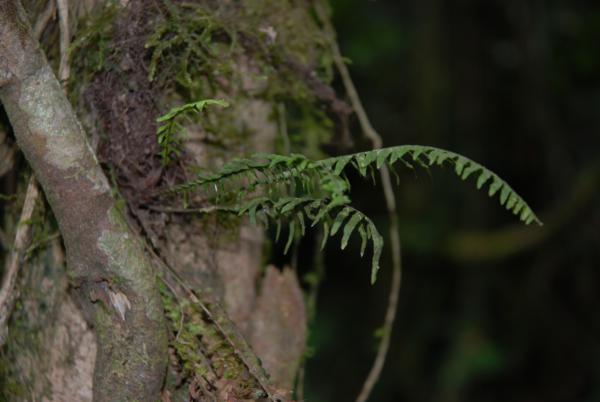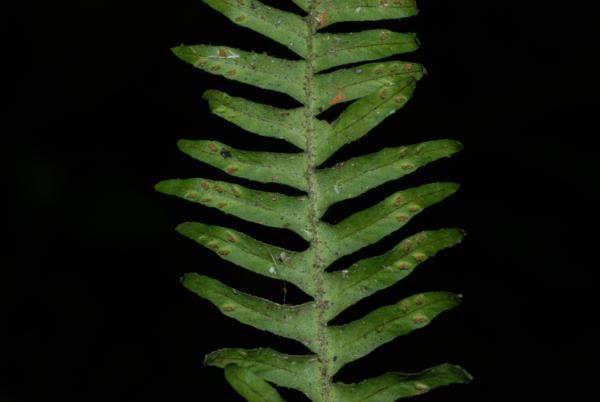
Prosaptia obliquata (Blume) Mett.
Family
Polypodiaceae
Nomenclature
Prosaptia obliquata (Blume) Mett. in Fenzl, Reise Novara 1: 214. 1870; Tardieu & C.Chr., Fl. Indo-Chine 7(2): 529. 1941; Tagawa & K.Iwats., SouthE. Asian Stud. 5: 63. 1967; Tagawa & K.Iwats., Fl. Thailand 3: 592. 1989; Boonkerd & Pollawatn, Pterid. Thailand: 294. 2000; Parris, Fl. Pen. Malaysia, Ser. I, Ferns & Lycoph. 1: 179. 2010. – Polypodium obliquatum Blume, Enum. Pl. Javae.: 128. 1828; Blume, Fl. Javae. Fil.: 181, t. 85B. 1829; Bedd., Handb. Ferns Brit. India: 311, f. 166. 1883. – Ctenopteris obliquata (Blume) Copel., Philipp. J. Sci. 81: 111. 1953; Holttum, Rev. Fl. Malaya ed. 1, 2: 221, f. 129. 1955 [‘1954’]. – Type: Blume s.n., Java, Mt Salak (holotype L).
Description
Rhizome short, creeping to ascending, bearing fronds in a tuft, scaly; scales narrowly subtriangular, up to 4 by 1 mm, long-acuminate at apex, clathrate with thick internal walls and transparent surfaces, densely hairy at margin with setose dark brown hairs, thinly leathery. Stipes 1.4–3 cm long, pale brown, densely hairy. Laminae linear-lanceolate to narrowly elliptic, gradually narrowing towards both ends, 22–40(–52) by 2.6–4(–6.1) cm wide, deeply lobed nearly to midrib, the wings less than 0.5 mm in breadth on both sides of midrib, middle lobes slightly ascending, gradually narrowing from base towards acuminate apex, up to 1.5–2.2(–3.5) cm by 2–4 mm, the lower ones gradually shorter and the upper ones becoming smaller upwards; thinly leathery to papyraceous; veins simple or rarely forked, hairy at margin of lobes with short, setose brown hairs. Sori terminal on veins, oblong, oblique, medial or submarginal, immersed with distinctly raised edges.
Distribution in Thailand
PENINSULAR: Phangnga, Krabi, Nakhon Si Thammarat.
Wider Distribution
S India, Sri Lanka, Thailand, Vietnam, S China, Taiwan, throughout Malesia.
Ecology
On mossy tree trunks in dense evergreen forests at medium or high altitudes, rather rare but locally abundant. Sometimes lithophytic on wet rocks.
Proposed IUCN Conservation Assessment
Least Concern (LC). This species is widespread and not under any known threat.
Voucher specimens - Thailand
Middleton et al. 4419, Nakhon Si Thammarat, Namtok Yong National Park (E); Van Beusekom & Phengkhlai 950, Nakhon Si Thammarat, Khao Luang (P); Larsen & Larsen 33479, Phangnga, Khao Paw Ta Luang Keo (P).
Habit
Lower surface of frond
Site hosted by the Royal Botanic Garden Edinburgh. Content managed by Stuart Lindsay, Gardens by the Bay, Singapore and David Middleton, Singapore Botanic Gardens. Last updated 24 January 2012

